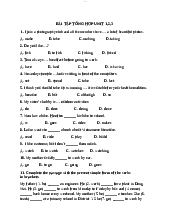










Preview text:
READING (120 minutes)
In this section, you will read TWO different
passages. Each one is followed by some questions.
Answer all the questions. Then, transfer your answers onto the answer sheet.
PASSAGE 1. Questions 1-10 (2.5 points)
Complete the following passage by choosing A, B, C or D to fill in each blank.
Around the world, forests are being __(1)__ at a rate of about thirteen million hectares a year and
deforestation accounts for an estimated 17% - 20% of all global emissions. In addition, forests
and other terrestrial carbon sinks play a __(2)__ role in preventing runaway climate change,
soaking up a full 2.6 Gt of atmospheric carbon every year. The destruction of forests, therefore,
not only emits carbon-a staggering 1.6 Gt a year, which severely __(3)__forests capacity to
absorb emissions from other sources-but also drastically __(4)__the amount of forested land
available to act as a carbon sink in the future.
However, the effects of deforestation extend beyond carbon. Rainforests __(5)__ a wide variety
of ecosystems services, from regulating rainfall to purifying groundwater and keeping fertile soil
from __(6)__; deforestation in one area can seriously damage food production and __(7)__ to
clean water in an entire region. The value of global ecosystem services has been estimated at 33
trillion USD each year (almost half of global GDP), but these services have been taken for
granted without a mechanism to make the market reflect their value. Rainforests are also a home
and __(8)__ of income for a huge number of people in Africa, Asia and South America. __(9)__
this, economic pressures frequently drive both logical communities and national governments in
the developing world to __(10)__ these forests in ways that are unsustainable, clear-cutting vast
areas for fuel, timber, mining or agricultural land.
1. A. ended B. destroyed C. extinct D. killed
2. A. tough B. important C. vital D. biggest 3. A. affects
B. diminishes C. increases D. impairs
4. A. plagues B. develops C. reduces D. shortens 5. A. sell B. offer C. give D. provide
6. A. transforming B. decoding C. erupting D. eroding
7. A. handiness B. excess C. availability D. access
8. A. beginning B. source C. ways D. references
9. A. Despite B. Also C. Inspite D. Apart
10. A. exploit B. encompass C. nurture D. work
PASSAGE 2. Questions 11-20 (2.5 points)
Read the passage and the questions below. For each question, write the correct letter A, B, C
or D on your answer sheet. The Creators of Grammar
No student of a foreign language needs to be told that grammar is complex. By changing word
sequences and by adding a range of auxiliary verbs and suffixes, we are able to communicate
tiny variations in meaning. We can turn a statement into a question, state whether an action has
taken place or is soon to take place, and perform many other word tricks to convey subtle
differences in meaning. Nor is this complexity inherent to the English language. All languages,
even those of so-called 'primitive' tribes have clever grammatical components. The Cherokee
pronoun system, for example, can distinguish between 'you and I', 'several other people and I'
and 'you, another person and I'. In English, all these meanings are summed up in the one, crude
pronoun 'we'. Grammar is universal and plays a part in every language, no matter how
widespread it is. So the question which has baffled many linguists is - who created grammar?
At first, it would appear that this question is impossible to answer. To find out how grammar is
created, someone needs to be present at the time of a language's creation, documenting its
emergence. Many historical linguists are able to trace modern complex languages back to earlier
languages, but in order to answer the question of how complex languages are actually formed,
the researcher needs to observe how languages are started from scratch. Amazingly, however, this is possible.
Some of the most recent languages evolved due to the Atlantic slave trade. At that time, slaves
from a number of different ethnicities were forced to work together under colonizer's rule. Since
they had no opportunity to learn each other's languages, they developed a make-shift language called a
. Pidgins are strings of words copied from the language of the landowner. pidgin They
have little in the way of grammar, and in many cases it is difficult for a listener to deduce when
an event happened, and who did what to whom. [A] Speakers need to use circumlocution in
order to make their meaning understood. [B] Interestingly, however, all it takes for a pidgin to
become a complex language is for a group of children to be exposed to it at the time when they
learn their mother tongue. [C] Slave children did not simply copy the strings of words uttered by
their elders; they adapted their words to create a new, expressive language. [D] Complex
grammar systems which emerge from pidgins are termed creoles, and they are invented by children.
Further evidence of this can be seen in studying sign languages for the deaf. Sign languages are
not simply a series of gestures; they utilise the same grammatical machinery that is found in
spoken languages. Moreover, there are many different languages used worldwide. The creation
of one such language was documented quite recently in Nicaragua. Previously, all deaf people
were isolated from each other, but in 1979 a new government introduced schools for the deaf.
Although children were taught speech and lip reading in the classroom, in the playgrounds they
began to invent their own sign system, using the gestures that they used at home. It was basically
a pidgin. Each child used the signs differently, and there was no consistent grammar. However,
children who joined the school later, when this inventive sign system was already around,
developed a quite different sign language. Although it was based on the signs of the older
children, the younger children's language was more fluid and compact, and it utilised a large
range of grammatical devices to clarify meaning. What is more, all the children used the signs in
the same way. A new creole was born.
Some linguists believe that many of the world's most established languages were creoles at first.
The English past tense –ed ending may have evolved from the verb 'do'. 'It ended' may once have
been 'It end-did'. Therefore, it would appear that even the most widespread languages were partly
created by children. Children appear to have innate grammatical machinery in their brains, which
springs to life when they are first trying to make sense of the world around them. Their minds
can serve to create logical, complex structures, even when there is no grammar present for them to copy.
11. In paragraph 1, why does the writer include information about the Cherokee language?
A To show how simple, traditional cultures can have complicated grammar structures
B To show how English grammar differs from Cherokee grammar
C To prove that complex grammar structures were invented by the Cherokees.
D To demonstrate how difficult it is to learn the Cherokee language
12. What can be inferred about the slaves' pidgin language?
A It contained complex grammar.
B It was based on many different languages.
C It was difficult to understand, even among slaves.
D It was created by the land-owners.
13. All the following sentences about Nicaraguan sign language are true EXCEPT:
A The language has been created since 1979.
B The language is based on speech and lip reading.
C The language incorporates signs which children used at home.
D The language was perfected by younger children.
14. In paragraph 3, where can the following sentence be placed?
It included standardised word orders and grammatical markers that existed in neither the pidgin
language, nor the language of the colonizers. A B C D
15. 'From scratch' in paragraph 2 is closest in meaning to: A from the very beginning B in simple cultures C by copying something else
D by using written information
16. 'Make-shift' in paragraph 3 is closest in meaning to: A complicated and expressive B simple and temporary C extensive and diverse D private and personal
17. Which sentence is closest in meaning to the highlighted sentence?
Grammar is universal and plays a part in every language, no matter how widespread it is.
A All languages, whether they are spoken by a few people or a lot of people, contain grammar.
B Some languages include a lot of grammar, whereas other languages contain a little.
C Languages which contain a lot of grammar are more common that languages that contain a little.
D The grammar of all languages is the same, no matter where the languages evolved.
18. All of the following are features of the new Nicaraguan sign language EXCEPT:
A All children used the same gestures to show meaning.
B The meaning was clearer than the previous sign language.
C The hand movements were smoother and smaller.
D New gestures were created for everyday objects and activities.
19. Which idea is presented in the final paragraph?
A English was probably once a creole.
B The English past tense system is inaccurate.
C Linguists have proven that English was created by children.
D Children say English past tenses differently from adults.
20. Look at the word 'consistent' in paragraph 4. This word could best be replaced by which of the following? A natural B predictable C imaginable D uniform
PASSAGE 3. Questions 1-10 (2.5 points)
Complete the following passage by choosing A, B, C or D to fill in each blank.
If China’s state-owned commercial banks seem burdened by bad debts, the Country’s rural
financial sector is even worse. In the villages, the only formal banking institutions are what are
known as rural credit co-operatives. These (1) _______ the
distinction in China of having been
officially declared insolvent. The rural credit co-operatives are ill named. They are often
reluctant to (2) ________ and they are not run as co-operatives as they do not (3) ________ any
profits and their customers have no say in their operations. Until 1996, they were offshoots of the
Agricultural Bank of China. Since then, they have been (4) ________ by the Central Bank,
though they are in reality run by country government. Even the word ‘rural’ is misleading. (5)
________ of their deposits are sucked up and put in the urban banking system. Farmers usually
find it easier to (6) ________ from friends or relatives or black market moneylenders. Yet the co-
operatives remain a big part of China’s financial system. Last year, they (7) ________ for 12
percent of deposits and 11 percent of loans. In recent years, commercial banks (including the
Agricultural bank) have closed down (8) ________ in the countryside. Yet some 40,000 credit
co-operatives remain in place with one in almost every township as the larger villages or smaller
rural towns are (9) ________. If as the government claims, the credit co-operatives are beginning
to turn a profit after six years of losses, it is not because they are any better run. In an effort to (10)
________ a stagnant rural economy, the central bank has pumped more than $9 billion
into them hoping that they will lend more to farmers. But the root causes of their problems
remain and the real solution may have to involve a mix of approaches from commercial banking to real cooperatives. 1. A. awarded B. enjoy C. worry D. making 2. A. sanctions B. apply C. part D. provide 3. A. function B. eligible C. claims D. share 4. A. own B. govern C. regulations D. supervised 5. A. Such B. Partly C. Whole D. Most 6. A. visit B. help C. borrow D. loan 7. A. include B. accounted C. fulfilled D. achieved 8. A. branches B. all C. operating D. staff 9. A. thinking B. known C. creating D. cross 10. A. make B. release C. boosting D. revitalise
PASSAGE 4. Questions 11-20 (2.5 points)
Read the passage and the questions below. For each question, write the correct letter A, B, C
or D on your answer sheet.
1) There has, in recent years, been an outpouring of information about the impact of buildings on
the natural environment; Information which explains and promotes green and sustainable
construction design, strives to convince others of its efficacy and warns of the dangers of
ignoring the issue. Seldom do these documents offer any advice to practitioners, such as those
designing mechanical and electrical systems for a building, on how to utilise this knowledge on a practical level.
2) While the terms green and sustainable are often considered synonymous, in that they both
symbolise nature, green does not encompass all that is meant by sustainability, which can be
defined as minimizing the negative impacts of human activities on the natural environment, in
particular those which have long-term and irreversible effects. Some elements of green design
may be sustainable too, for example those which reduce energy usage and pollution, while
others, such as ensuring internal air quality, may be considered green despite having no influence on the ecological balance.
3) Although there are a good many advocates of ‘green’ construction in the architectural
industry, able to cite ample reasons why buildings should be designed in a sustainable way, not
to mention a plethora of architectural firms with experience in green design, this is not enough to
make green construction come into being. The driving force behind whether a building is
constructed with minimal environmental impact lies with the owner of the building; that is, the
person financing the project. If the owner considers green design unimportant, or of secondary
importance, then more than likely, it will not be factored into the design.
4) The commissioning process plays a key role in ensuring the owner gets the building he wants,
in terms of design, costs and risk. At the predesign stage, the owner’s objectives, criteria and the
type of design envisaged are discussed and documented. This gives a design team a solid
foundation on which they can build their ideas, and also provides a specific benchmark against
which individual elements, such as costs, design and environmental impact can be judged.
5) Owners who skip the commissioning process, or fail to take ‘green’ issues into account when
doing so, often come a cropper once their building is up and running. Materials and equipment
are installed as planned, and, at first glance, appear to fulfil their purpose adequately. However,
in time, the owner realises that operational and maintenance costs are higher than necessary, and
that the occupants are dissatisfied with the results. These factors in turn lead to higher ownership
costs as well as increased environmental impact.
6) In some cases, an owner may be aware of the latest trends in sustainable building design. He
may have done research into it himself, or he may have been informed of the merits of green
design through early discussion with professionals. However, firms should not take it as read that
someone commissioning a building already has a preconceived idea of how green he intends the
structure to be. Indeed, this initial interaction between owner and firm is the ideal time for a
designer to outline and promote the ways that green design can meet the client’s objectives, thus
turning a project originally not destined for green design into a potential candidate.
7) Typically, when considering whether or not to adopt a green approach, an owner will ask
about additional costs, return for investment and to what extent green design should be the
limiting factor governing decisions in the design process. (1) Many of these costs are incurred by
the increased cooperation between the various stakeholders, such as the owner, the design
professionals, contractors and end-users. (2) However, in green design, they must be involved
from the outset, since green design demands interaction between these disciplines. (3) This
increased coordination clearly requires additional expenditure. (4) A client may initially balk
at these added fees, and may require further convincing of the benefits if he is to proceed. It is up
to the project team to gauge the extent to which a client wants to get involved in a green design
project and provide a commensurate service.
8) Of course, there may be financial advantage for the client in choosing a greener design. Case
studies cite examples of green / sustainable designs which have demonstrated lower costs for
long-term operation, ownership and even construction. Tax credits and rebates are usually
available on a regional basis for projects with sustainable design or low emissions, among others.
11. The writer’s main purpose is to…
A. explain to professionals how they can influence clients to choose greener designs.
B. explain the importance of green building design in reducing long-term damage to the environment.
C. explain to owners commissioning a building why ignoring green issues is costly and dangerous.
D. explain to professionals why it is important to follow the correct procedures when a building is commissioned.
12. The examples of green and sustainable designs given in paragraph 2 show that
A. designs must be sustainable in order for them to be described as green.
B. for the purposes of this paper, the terms green and sustainable have the same meaning.
C. some sustainable designs are green, while others are not.
D. some designs are termed green, even though they are not sustainable.
13. According to paragraph 3, the reason for the lack of green buildings being designed is that…
A. few firms have any experience in design and constructing buildings to a green design.
B. construction companies are unaware of the benefits of green and sustainable designs.
C. firms do not get to decide whether a building is to be constructed sustainably.
D. firms tend to convince clients that other factors are more important than sustainability.
14. Which of the following is NOT true about the commissioning process?
A. It is conducted before the building is designed.
B. It is a stage that all clients go through when constructing a building.
C. It is a step in the design procedure in which the client’s goals are identified.
D. It provides the firm with a measure of how well they did their job.
15. In paragraph 5, what does the phrase ‘come a cropper’ mean? A. experience misfortune B. change one’s mind C. notice the benefits D. make a selection
16. In paragraph 6, the writer implies that…
A. most clients enter the commissioning process with a clear idea of whether or not they want a green building.
B. designers are usually less concerned about green design than the clients are.
C. the commissioning process offers a perfect opportunity to bring up the subject of green design.
D. firms should avoid working with clients who reject green designs in their buildings.
17. Where in paragraph 7 does this sentence belong?
In a typical project, landscape architects and mechanical, electrical and plumbing engineers do
not become involved until a much later stage. A. 1 B. 2 C. 3 D. 4
18. In paragraph 7, what does ‘balk at’ mean? A. display shock towards B. agree to pay C. question the reason for D. understand the need for
19. Green buildings are most likely to incur more expense than conventional buildings due to…
A. higher taxes incurred on sustainable buildings.
B. higher long-term operational costs.
C. the higher cost of green construction materials.
D. increased coordination between construction teams.
20. Read the 3 sentences below. Which sentence best express the most important idea in the passage?
A. Green, sustainable buildings are advantageous not only in terms of environmental impact.
There are financial benefits as well.
B. Ensuring good internal air quality is one way of ensuring that occupants are satisfied with a building’s design.
C. Most clients are prepared to pay extra in order to receive the benefits of green building design.
D. Architects are more interested in green building design than other contractors, such as engineers and plumbers.




